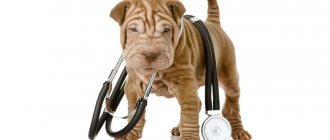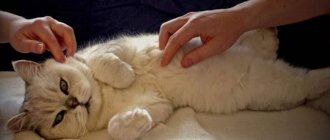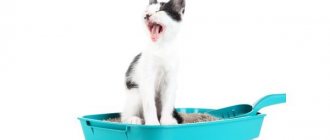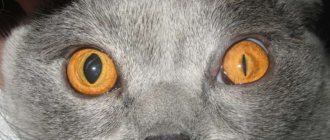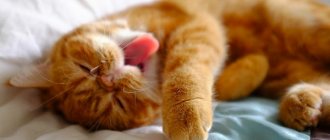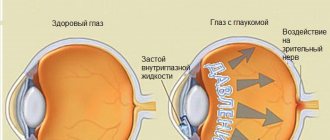Like humans, the average blood pressure in a cat is 120/80 mm Hg. Art. To measure the indicators, a special veterinary tonometer is used. If the value deviates from the optimal level, detailed diagnostics should be carried out and the causes of the violation should be found out. Like people, cats suffer from hypertension and hypotension. These diseases negatively affect the general condition and functioning of the pet. Therefore, it is important to establish an accurate diagnosis in a timely manner and begin treatment.
What are the norms?
Blood pressure (BP) shows the condition of the vascular walls, their physiological resistance, as well as heart rate. The indicator is measured in millimeters of mercury - mmHg. Art. and consists of two values separated by a fraction sign. The first indicator characterizes the level of blood pressure on the walls of the vessel at the moment of maximum heart contraction. The second is the strength of blood pressure at the moment of greatest relaxation of the heart muscle. Normal blood pressure in cats is the same as in humans and averages 120/80 mmHg. Art. If something is wrong with the body and pathological processes develop inside, blood pressure becomes low or high. The main thing is to notice these changes in time and, if necessary, try to eliminate them.
Treatment of the disease
Normal a/d in cats is on average 120 per 80 mmHg. An animal needs medical attention in the following cases:
- pressure above 150/100 mmHg. - with these numbers, constant monitoring is established;
- pressure above 160/120 mmHg. - begin antihypertensive therapy.
Treatment of hypertension in cats is usually carried out in several stages:
- Normalization of blood pressure with the help of antihypertensive drugs (Amlodipine, Benazepril, Lisinopril). In some cases, these drugs are prescribed to the animal for life.
- Elimination of edema using diuretics (Diacarb).
- Elimination of the cause of high blood pressure (in the case of secondary symptomatic hypertension).
- Constant monitoring of the condition of the kidneys and eyes.
During treatment, it is necessary to provide the animal with constant rest and protect it from stressful situations.
Why measure?
Measuring blood pressure in dogs and cats must be carried out periodically, so that if any disorders progress in the body, they can be noticed in a timely manner and eliminated before complications arise. Blood pressure must be measured at a preventive appointment, which helps reduce the risk of sudden development of a crisis, heart and kidney failure, endocrine and hormonal disorders. The indicators are monitored during and after surgical treatment, because during surgery there is always a risk of internal bleeding and a sharp drop in blood pressure.
Leading veterinary experts advise measuring blood pressure once a year in cats that have reached 5-7 years of age. If Murka is 10 years old or older, measurements should be taken at least once every six months.
Measuring blood pressure in dogs and cats
At the Constellation Veterinary Center you can measure the blood pressure of a cat, dog, or even a rodent. Blood pressure is measured using a specialized veterinary tonometer. You can take a measurement at any time, the veterinary clinic is open 24 hours a day.
It is believed that cats and dogs are not subject to the same stress that their owners experience; their food usually does not contain a lot of salt and is not as fatty as ours. Why can dogs and cats have high blood pressure?
Blood pressure in dogs and cats
Everyone knows that blood pressure readings are extremely important for our health. Medical doctors recommend measuring it regularly and taking action if it deviates from the norm.
How important is measuring blood pressure in cats and dogs?
It is believed that cats and dogs are not subject to the same stress that their owners experience; their food usually does not contain a lot of salt and is not as fatty as ours. Why can dogs and cats have high blood pressure?
In fact, high blood pressure (hypertension) occurs in dogs and cats much more often than we used to think.
In humans, primary hypertension is most common, for example due to changes in weather, i.e. not caused by any disease. In cats and dogs, hypertension more often develops secondary hypertension, which appears against the background of another disease.
What is considered normal blood pressure in dogs and cats?
A person's normal blood pressure is 120 over 80, which means a systolic pressure of 120 mmHg (mmHg) and a diastolic pressure of 80 mmHg. RT Art. Systolic pressure indicates the highest blood pressure in the body, while diastolic pressure indicates the lowest during the heartbeat.
Dogs' blood pressure varies depending on their size. The larger the animal, the slightly higher the indicators will be. It should also be taken into account that the table shows indications for the animal at rest. If the dog was stressed before measuring blood pressure, the blood pressure will be higher. Stress caused by visiting a veterinary clinic may also affect the readings.
Normal blood pressure in dogs
| Dog breed | Systolic pressure, mm. Hg Art. | Diastolic pressure, mm. Hg Art. |
| Labrador Retriever | 118±17 | 66±13 |
| Golden Retriever | 122±14 | 70±11 |
| Pyrenean mountain dog | 120±16 | 66±6 |
| Yorkshire Terrier | 121±12 | 69±13 |
| West Highland Terrier | 126±6 | 83±7 |
| Border Collie | 131±14 | 75±12 |
| Cavalier King Charles Spaniel | 131±16 | 72±14 |
| German Shepherd | 132±13 | 75±10 |
| Terrier | 136±16 | 76±12 |
| Bull Terrier | 134±12 | 77±17 |
| Chihuahua | 134±9 | 84±12 |
| Miniature dog breeds | 136±13 | 74±17 |
| Pomeranian Spitz | 136±12 | 76±13 |
| Beagle | 140±15 | 79±13 |
| Dachshund | 142±10 | 85±15 |
| Saluki | 143±16 | 88±10 |
| Greyhound | 149±20 | 87±16 |
| Pointer | 145±17 | 83±15 |
Normal blood pressure in cats
| Cat breed | Systolic pressure, mm. Hg Art. | Diastolic pressure, mm. Hg Art. |
| All cats | 124±16 | 80±14 |
Why is it necessary to measure blood pressure in dogs and cats?
When a dog or cat develops hypertension (high blood pressure), the blood vessels become very narrow and cannot pump the required volume of blood. As an example, if you connect a regular watering hose to a fire hydrant, it will squirm under pressure and may even burst. The same thing happens with blood vessels.
Typically, the affected vessels in pets are small, so bleeding and lack of blood in the area being fed may go unnoticed for a long time until the problem becomes too large. The same thing happens in people - it’s not for nothing that hypertension is called the “silent killer”.
What can happen to a cat or dog with high blood pressure?
Hypertensive dogs and cats have an increased risk of damage to internal organs. The eyes are often affected, which can lead to sudden or gradual blindness in a dog or cat. The owner can detect damage by dilated pupils that do not respond to light or when the pet stops noticing obstacles and “bumps” into them.
The kidneys, liver and brain are also affected by high blood pressure: kidney problems worsen, heart failure occurs, and the risk of a heart attack increases.
There are a number of diseases associated with high blood pressure in dogs and cats:
- Chronic renal failure
- Cushing's disease
- Diabetes
- Obesity
- Heart diseases
- Hyperthyroidism (cats)
When should dogs and cats have their blood pressure measured?
If a dog has the above problems, if there are problems with the vision or nervous system, it is recommended to regularly measure blood pressure.
Elderly animals are recommended to measure blood pressure when clarifying any diagnosis.
How to measure blood pressure in a dog or cat?
Conventional pressure measuring devices (tonometers) are not suitable for dogs and cats. The fact is that often the size of animals and their fur do not allow the use of tonometers used in human medicine. Even blood pressure monitors specifically designed for measuring blood pressure in infants are not suitable for cats and dogs.
To measure blood pressure in dogs and cats, we use a special veterinary tonometer, PetMap Graphic II. This tonometer is specially designed for animals. A set of cuffs allows you to measure blood pressure and heart rate (pulse) in the smallest kittens and puppies, as well as in large dogs with long hair.
The tonometer for dogs and cats measures blood pressure with high accuracy (±2 mm Hg) in the following ranges:
- systolic 40–265 mm. Hg Art.
- diastolic 25-195 mm. Hg Art.
The tonometer also measures heart rate in the range from 40 to 220 beats per minute.
What to do if your cat or dog has high blood pressure?
Depending on the severity of the condition, the type of animal and concomitant diseases, the veterinarian will prescribe a drug intended for the treatment of hypertension in animals.
It is important to remember that high blood pressure in pets is often the cause of other diseases; simply lowering it, as a rule, does not lead to a solution to the problem as a whole. That is why a full diagnosis of the animal’s condition is necessary, where measuring pressure is only one of the procedures.
How to measure pressure?
For this procedure, a special digital device is often used.
Various techniques are used to measure blood pressure in cats. The safest and most accurate is to record indicators using a mechanical or digital veterinary tonometer. The cuff is fixed to the paw or tail, then the air should be inflated using a bulb. The finished value will appear on the digital monitor. For greater accuracy and reliability of the data, it is recommended to measure the pressure several times.
The “gold standard” for measuring blood pressure is a direct method performed by peripheral artery catheterization. The procedure is invasive and requires anesthesia to reduce the cat's motor activity, so it is used in extreme cases. Depplerography, ultrasound, photoplethysmography methods are used in advanced veterinary clinics, as they require modern, high-tech equipment. Accordingly, the price of the procedure will be higher.
How to measure blood pressure in cats
In modern veterinary practice, several methods of measuring blood pressure in animals are used:
- Invasive (direct) method. Known to everyone without exception, since it uses a cuff, a bulb and a tonometer.
- Sometimes pressure is measured using ultrasound.
- The most accurate (and recently it is being practiced more and more often) is the oscillometric method. It is a combination of the traditional (direct) method and modern technologies.
The most preferred method is oscillometric. The cuff is placed on the base of the tail or on the paw. When using modern devices for measuring blood pressure, the veterinarian only needs to inflate the cuff with air (or the device will do this automatically). Within a few seconds the result will be displayed on the screen.
What can cause high blood pressure?
Arterial hypertension in cats is diagnosed when blood pressure exceeds 150/95-110 mm Hg. Art. In this case, the animal is closely monitored and data is regularly recorded. If the values fluctuate at 160/120, complex drug therapy is urgently prescribed. A blood pressure of 180/120 is considered critical. With such indicators, a hypertensive crisis can occur at any time. In this case, the cat is hospitalized and given emergency care. Based on etiology, there are systemic, secondary and pulmonary hypertension in cats.
Common causes of high blood pressure in cats are:
Indicators may be elevated in animals suffering from diabetes.
- cardiac and vascular pathologies;
- kidney and adrenal dysfunction;
- dysfunction of the thyroid gland;
- progression of systemic pathologies, for example, diabetes.
Portal hypertension, in which high pressure is recorded in the portal veins, can be caused by the following pathologies:
- thrombosis of large vessels;
- splenomegaly;
- hepatitis of various types;
- cirrhosis or fibrosis of the liver;
- cardiovascular diseases.
Symptoms of the disease
High blood pressure primarily worsens the condition of the eyes, cardiovascular and nervous systems. The main symptoms of hypertension appear in these organs. The signs and pathophysiology of arterial hypertension in cats are as follows:
- Vision deteriorates sharply, dilated pupils and retinal hemorrhages are observed. In severe cases, retinal detachment, the development of glaucoma and even complete blindness can occur.
- On the part of the nervous system, unsteadiness of gait is often observed due to deterioration of coordination. Later lethargy, apathy, and increased drowsiness appear.
- From the respiratory system - shortness of breath, oxygen starvation.
- Increased swelling is also characteristic (the paws are especially swollen).
- Sometimes nosebleeds occur.
Main reasons for the decline
In cats, hypotension is rarely diagnosed, and the condition often progresses against the background of other primary pathologies. Arterial hypotension does not occur on its own. The primary sources of low blood pressure are:
Anesthetic drugs may slightly reduce these indicators.
- heavy internal and external bleeding;
- state of shock;
- exposure to anesthetic during surgery;
- uncontrolled use of certain groups of drugs.
Why should a cat need to measure blood pressure?
Most often, pressure is measured during or after operations in order not to miss a critical drop in its level against the background of hidden internal bleeding (hypotension).
During routine appointments, it is important to measure blood pressure in order to promptly identify a condition such as arterial hypertension (persistently maintained high blood pressure), which accompanies many pathological conditions of the body (heart failure, pathologies of the kidneys and/or endocrine system, etc.).
In order not to miss hypertension, it is recommended to regularly measure the blood pressure of Murkas whose age is over 5-7 years old - at least once a year, over 10 years old - once every six months. This is a mandatory frequency. This is especially true for individuals whose behavior attracts attention as unusual.
Symptoms of horse racing
Hypertension in cats in the initial stages of development is often asymptomatic. But as the animal’s condition progresses, it becomes noticeably impaired. The cat becomes lethargic, apathetic, sleeps a lot, sometimes refuses to eat, and moves little. Other signs of high blood pressure include:
- dilated pupils;
- abundant vascular network on the cornea;
- visual impairment, retinal detachment;
- photophobia;
- disorientation in space, staggering gait;
- dyspnea;
- formation of edema on the paws;
- convulsions;
- causeless, prolonged meowing.
If the pressure rises to 180/120 mmHg. Art., the risk of developing a hypertensive crisis increases. The pet experiences a coma, increased heart rate, shortness of breath, and profuse drooling.
With reduced levels, the animal becomes excessively drowsy.
With hypotension, blood pressure drops to 90/60 or less. Sudden changes accompanied by characteristic symptoms negatively affect the general condition of the cat. When the indicators decrease, the animal exhibits the following signs:
- slow heart rate;
- drowsiness, weakness;
- fainting;
- tremor of the limbs;
- blanching of the mucous membrane.
High pressure features
Secondary hypertension in cats can develop against the background of serious pathologies, such as:
- diabetes;
- heart failure;
- endocrinological disorders (hyperthyroidism);
- Cushing's disease (increased synthesis of adrenal hormone);
- jades.
Pressure that lasts for a long time has a detrimental effect on the condition of the eyes. In addition, the walls of blood vessels are damaged and blood viscosity increases. A decrease in blood flow causes a decrease in the rate of metabolic processes in tissues. All this is fraught with serious consequences for the body. Therefore, during each routine preventive examination of your pet, it is necessary to measure the pressure.
It is also very important to periodically measure the a/d of individuals who are already 5-7 years old. At this age, animals become susceptible to primary hypertension.
What treatment is prescribed?
If your cat exhibits symptoms of high blood pressure, you should immediately take her to see a veterinarian. The fact is that you won’t be able to measure the indicators yourself at home, since a special veterinary tonometer is used for the procedure. An ordinary human will not show exact values. For arterial hypertension, tablets that normalize blood pressure are prescribed:
- "Amlodipine";
- "Enalapril";
- "Lisinopril";
- sodium nitroprusside.
If the pet is prone to edema, then Torasemide is prescribed.
The treatment regimen and dosage are determined by the doctor individually. In the presence of edema, diuretics must be used:
- "Furosemide";
- "Torasemide".
Treatment of hypotension is carried out only in a hospital. Self-medication at home is contraindicated. The following procedures apply:
- infusion of plasma replacement solutions;
- antishock therapy;
- injections that stimulate cardiac activity.
Symptoms
Signs of hypertension in the initial stages are rather weak and nonspecific. Owners usually attribute them to age or underlying disease.
You can suspect high blood pressure in a dog based on the following signs:
- swelling of the limbs;
- unsteady gait;
- fainting;
- restless behavior;
- increased heart rate;
- poor spatial orientation caused by impaired vision;
- loss of appetite;
- nosebleeds;
- burst blood vessels in the eyes.
In cats, you may also notice restless behavior; she may meow for no reason and look for a place for herself. In addition, the pupils of pets dilate, and when measuring the pulse, its increase is noted. The animal is lethargic and drinks frequently.
How can I help you
Treatment is prescribed only by a veterinarian based on examination and collection of information, interviewing the owner of the mustachioed patient. Therapy is carried out in two parallel or sequential stages - the underlying disease is treated and blood pressure levels are normalized. During treatment, the functioning of the renal system and eyes must be monitored. Often, elimination of the underlying disease leads to normalization of blood pressure and the need for antihypertensive therapy disappears. The duration of the treatment course is determined strictly by a veterinary specialist. Often, antihypertensive medications remain on an ongoing basis.
- amlodipine (90-180 rubles, depending on the number of tablets in the package): orally from 0.5 to 1.25 mg/animal or 0.2 mg/kg once a day or once every 48 hours (two days). It is advisable to divide the tablet with a special tablet knife to reduce the risk of dosage violations. It is not addictive and the effectiveness of long-term use does not decrease.
- enalapril, benazepril (65-300 rubles, depending on the manufacturer) : orally 0.25-0.5 mg/kg of animal weight once a day. Often used in combinations at a dosage of 1.25-1.5 mg/animal per day. In very severe cases, the dose can be doubled, and after stabilization, the dose can be returned to normal levels.
- lisinopril (within 120-150 rubles/pack of 30 tablets): initial maintenance dose of 0.125 mg/kg of body weight, maximum permissible dose during the day – 0.5 mg/kg. Monitoring of kidney function is required. The course lasts 1-2 months, then you need to replace it with drugs that can be taken for a long time.
- sodium nitroprusside : for emergency relief of hypertensive crisis. The dosage is determined only by a specialist and is administered only in a hospital! Dose: 1.5-5 mcg/kg body weight at a rate of 1 minute. Strict monitoring of the animal’s condition is indicated, because a sharp drop in pressure can lead to disruption of brain function (ischemia).
We recommend reading: Kholmogory breed cattle cow breeding maintenance
In the presence of edema, diuretics are prescribed:
- furosemide (about 30 rubles/pack of 10 ampoules): 0.5-1 mg/kg per day orally or intramuscularly (injections act faster). The duration of use is determined by the veterinarian based on the general condition;
- torasemide (about 250 rubles/pack of 20 tablets): orally 0.05-0.1 mg/kg once a day. There are cats that are not sensitive to it - there is no pattern, just an individual reaction.
Prevention
A healthy and cheerful dog is a joy for the owner. Therefore, it is extremely important to pay attention to all factors that may be the probable cause of your pet’s ill health, including an increase or decrease in blood pressure.
Preventive measures to keep your dog's blood pressure in the normal range:
- dietary, but nutritious and regular meals;
- daily walks in the fresh air with physical activity appropriate for the dog’s age;
- absence of stressful situations;
- following the veterinarian's recommendations if the dog has already been diagnosed with hypertension. As a rule, this is a lifelong use of medications that lower blood pressure;
- periodic blood pressure measurements and, if necessary, contact a veterinary clinic.
Only if you follow these recommendations can you be sure that your dog’s blood pressure is normal. This will increase your dog's chances of a healthy and happy life.
